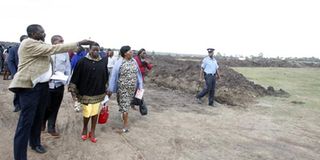Did dead man sell Karen land?

Parliamentary Land Committee chairman Alex Mwiru (left) visits the controversial land in Karen with his team on October 27,2014. PHOTO | EVANS HABIL |
What you need to know:
- Over 40 MPs reported to be among top Jubilee officials who have benefited.
The ownership battle over the controversial Sh8 billion 134-acre land in Karen has taken a new turn after the names of Arnold Bradley and lawyer Fredrick Hopley were mentioned in transactions they were allegedly involved in many years after they had died.
According to documents filed in the High Court, John Mugo Kamau directly bought the land from Mr Bradley on August 24, 1978 through lawyer Hopley.
However, records in the same court show that Mr Bradley died on October 22, 1974 — four years before he purportedly signed the document.
Records before the court also show that Mr Hopley, the lawyer who allegedly processed the documents for Mr Mugo, had been dead 18 years on July 27, 1960 while the documents were signed on August 23, 1978.
The death of Mr Hopley was published in the Kenya Gazette number 4131 of September 6, 1960.
Barclays Bank’s trustees department notice invites anyone with a claim against the Estate of Fredrick Hurlingh Hopley, of Sotik, Kenya colony, who died in Nairobi, Kenya, on July 27, 1960 to send particulars to Barclays Bank.
The court dispute over the land involves Muchanga Investments Ltd, associated with businessman Horatius Da Gama Rose, and Telesource.com, a company linked to a former managing trustee of the National Social Security Fund, Josphat Konzolo.
The saga is said to have sucked in influential individuals, including politicians, who were allegedly allocated pieces of the land. A court order barring any interference with the property was eventually enforced.
But in new developments contained in an affidavit filed by Mr Konzolo of Telesource.com on January 6, 2015, Mr Mugo allegedly bought the land from Mr Bradley in 1978.
Mr Konzolo’s company then supposedly bought it on October 21, 2005. In the affidavit, Mr Konzolo says that Barclays had nothing to do with the land.
“The property known as sub-division LR 3685/2/3 was not and has never been vested to Barclays Bank of Kenya. The bank therefore did not have the mandate or legal right to sell the property to the applicant,” says Mr Konzolo.
According to Mr Konzolo, who was replying to documents filed by Barclays in support of Muchanga Investment’s ownership, the land was never charged to the bank as claimed.
“Mr John Mugo was the first registered and indefeasible owner of the property known as LR 3586/3 and his title was legally, legitimately obtained and the sale was for value, namely Sh32,000,000. This title is therefore indefeasible and protected under the land laws of the Republic of Kenya,” says Mr Konzolo.
But a January 29, 2015 affidavit signed by Muchanga owner Da Gama Rose says that Mr Mugo had no title to transfer to Mr Konzolo.
Mr Da Gama Rose says his company charged the property to Barclays as security between 1983 and 1989.
He attached minutes, letters between the two institutions, and minutes of Muchanga Investment board meeting attended by one-time Vice-President Moody Awori and his wife Rose. The minutes are dated April 29, 1983.
In the court case, Muchanga Investments has also sued Jina Enterprises, Habenga Ltd, Director of Physical Planning, Director of Survey, and Chief Lands Registrar, among others.
BENEFITED
Last year, the Sunday Nation reported that at least 40 MPs were among top Jubilee government officials and politicians believed to have benefited from the land-grab in a bid to buy their silence.
Last year, amid public anger, President Uhuru Kenyatta said anyone implicated in the alleged land-grab would be punished.
The Ethics and Anti-Corruption Commission and the National Assembly committee on land are also investigating the matter.
Land Secretary Charity Ngilu has previously said she does not know who owns the land.




